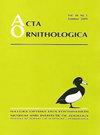Foraging Niche Differentiation Among Sympatric Woodpecker Species in Forests of North-Western India
IF 1.3
4区 生物学
Q3 ORNITHOLOGY
引用次数: 5
Abstract
Abstract. The sub-Himalayan dipterocarp forests of subtropical region in northwest India support 17 species of woodpecker. From a conservation perspective it is necessary to assess the ecological requirements of woodpeckers in these biologically diverse landscapes, which are experiencing habitat modification and decline in some woodpeckers. We studied the foraging niche differentiation among ten sympatric woodpeckers in the sub-Himalayan forests of northwest India: Dendrocopos canicapillus, D. macei, Picus chlorolophus, P. xanthopygaeus, P. canus, Dinopium shorii, D. benghalense, Chrysophlegma [Picus] flavinucha, Chrysocolaptes lucidus, and Mulleripicus pulverulentus. We examined the foraging site preferences of individual woodpecker species and explored the role of inter-specific differences in foraging behaviour as a possible mechanism for their coexistence. Observations on foraging woodpeckers were taken vis-a-vis the following niche dimensions: diameter of the foraging tree, height of the foraging bird, type of substrate on which it was foraging, vertical position with respect to canopy, condition of the forage tree and condition of the substrate. Distinct preferences were evident among species in their foraging tree diameters, foraging heights, vertical positions, and choice of substrate type, while preference for dead substrates was not an important distinguishing factor. Species that overlapped in one dimension generally segregated along other dimensions. Niche segregation in forage tree diameter was associated with body weight. Based on their overall niche overlaps species could broadly be differentiated into groups according to body size viz. small (3 species), medium (3 species), large (3 species), and very large (1 species). Our study demonstrates that differentiation in foraging may be a likely mechanism for coexistence of sympatric woodpeckers in this region. Given that larger species prefer larger substrates, removal of mature trees could affect their abundance, and homogenisation of stand structure could lead to impoverishment of woodpecker diversity.印度西北部同域啄木鸟觅食生态位的分异
摘要印度西北部亚热带地区的亚喜马拉雅双龙果林供养着17种啄木鸟。从保护的角度来看,有必要评估这些生物多样性景观中啄木鸟的生态需求,这些景观正在经历栖息地的改变和一些啄木鸟的减少。本文研究了印度西北亚喜马拉雅森林中10种同域啄木鸟(Dendrocopos canicapillus、D. macei、Picus chlorolophus、P. xanthopygaus、P. canus、Dinopium shorii、D. benghalense、Chrysophlegma [Picus] flavinucha、Chrysocolaptes lucidus和Mulleripicus pululentus)的觅食生态位分化。研究了啄木鸟个体的觅食地点偏好,并探讨了种间差异在觅食行为中的作用,作为它们共存的可能机制。对啄木鸟的生态位维度进行了观察:觅食树的直径、觅食鸟的高度、觅食的基质类型、相对于冠层的垂直位置、觅食树的状况和基质的状况。不同树种对取食树径、取食高度、取食垂直位置和取食基质类型的偏好有显著差异,对枯死基质的偏好不是重要的区分因素。在一个维度上重叠的物种通常沿着其他维度分离。饲料树径的生态位分离与体重有关。根据整体生态位重叠情况,物种大致可按体型划分为小型(3种)、中型(3种)、大型(3种)和超大型(1种)。我们的研究表明,觅食差异可能是该地区同域啄木鸟共存的可能机制。由于体型较大的啄木鸟喜欢更大的基质,成熟树木的移除可能会影响它们的丰度,而林分结构的同质化可能导致啄木鸟多样性的枯竭。
本文章由计算机程序翻译,如有差异,请以英文原文为准。
求助全文
约1分钟内获得全文
求助全文
来源期刊

Acta Ornithologica
生物-鸟类学
CiteScore
2.10
自引率
0.00%
发文量
14
审稿时长
>12 weeks
期刊介绍:
Publishes scientific papers (original research reports, reviews, short notes, etc.) and announcements from all fields of ornithology. All manuscripts are peer-reviewed.
Established in 1933 as Acta Ornithologica Musei Zoologici Polonici, since 1953 continued under the present title.
Published twice a year by the Natura Optima Dux Foundation under the auspices of the Museum and Institute of Zoology, Polish Academy of Sciences.
 求助内容:
求助内容: 应助结果提醒方式:
应助结果提醒方式:


